14 December
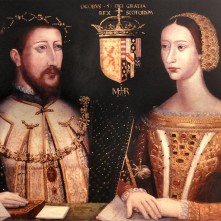
James V and Marie de Guise
1542 - Death of James V at Falkland Palace, Falkland, Fife, and accession of his daughter, Mary, Queen of Scots. James was buried at Holyrood Abbey on 8th January 1543.
1558 – Burial of Queen Mary I at Westminster Abbey in the Henry VII chapel with only stones marking her grave. In 1606, forty-eight years after her death, the stones were cleared, Elizabeth I's coffin was added to the vault, and James I commissioned a monument to Elizabeth I.
1562 – Death of William Grey, 13th Baron Grey of Wilton and military commander, during the night of 14th/15th December at the home of his son-in-law, Henry Denny, at Cheshunt in Hertfordshire. Grey served as a commander in the expedition to France in 1544, as Field-Marshal and Captain-General of Horse in Scotland in 1547, as a soldier in France in 1557, and as Warden of the Eastern and Middle Marches in 1559.
1563 – Baptism of Thomas Belson, Roman Catholic martyr, at Aston Rowant Church in Oxfordshire. He was hanged on 5th July 1589 for assisting the Catholic priests, George Nichols and Richard Yaxley, who were hanged, drawn and quartered on that day.
1563 – Burial of William Dacre, 3rd Baron Dacre of Gilsland and 7th Baron Greystoke, at Carlisle Cathedral.
1585 – Burial of Thomas Bentley, editor of “The Monument of Matrones: Conteining Seven Severall Lamps of Virginitie, or Distinct Treatises; Whereof the First Five Concerne Praier and Meditation: the Other Two Last, Precepts and Examples” (1582), a collection of prayers and meditations for and by women. It is said to be the first published anthology of English women's writing. Bentley was buried at St Andrew's, Holborn.
1592 – Death of Sir Roger Manwood, judge, member of Parliament and Elizabeth I's Lord Chief Baron of the Exchequer, in St Stephen's Parish, Hackington, near Canterbury.
1593 – Death of Henry Radcliffe, 4th Earl of Sussex, soldier, member of the Irish Privy Council, member of Parliament and patron of the Earl of Sussex's men. He was buried at Borham in Essex.
1595 – Death of Henry Hastings, 3rd Earl of Huntingdon, administrator, diplomat, and military commander, at York. He was buried at St Helen's Church, Ashby-de-la-Zouch. Huntingdon was educated with the young Edward VI, and served in the household of Cardinal Reginald Pole, his great-uncle. He served Elizabeth I as President of the Council of the North, and was one of the peers at the trial of Mary, Queen of Scots in 1586.
1624 – Death of Charles Howard, 2nd Baron Howard of Effingham and 1st Earl of Nottingham, at Haling in Surrey. He was buried at Reigate Church in the family vault. Nottingham served Elizabeth I and James I as Lord High Admiral, and commanded the English forces against the Spanish Armada in 1588.
15 December
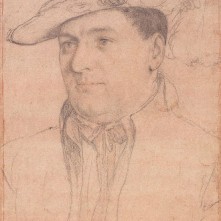
Thomas Parry
1558 – Funeral of Reginald Pole, Cardinal Pole and Mary I's Archbishop of Canterbury, at Canterbury Cathedral.
1560 – Death of Thomas Parry, Comptroller of the Household to Elizabeth I and Lord Lieutenant of Berkshire. He was buried at Westminster Abbey.
1605 – Death of Sir Francis Gawdy, Judge and Chief Justice of the Common Pleas, of apoplexy at Sergeant's Inn. He had only been Chief Justice for four months. As Queen's Sergeant in 1586, Gawdy had opened the trial against Mary, Queen of Scots. He was buried at Rungton, near Wallington in Norfolk.
16 December
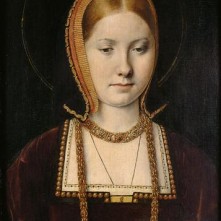
Woman thought to be Catherine of Aragon
1503 (16th or 18th) – Death of George Grey, 2nd Earl of Kent, at Ampthill, Bedfordshire. He was buried at Warden Abbey, Bedfordshire, where his first wife, Anne Woodville (sister of Elizabeth Woodville), had been laid to rest in 1489. Grey's second wife, Catherine Herbert, daughter of William Herbert, 1st Earl of Pembroke, was also buried there after her death in 1504. Grey was on Henry VII's council, was Constable of Northampton Castle and was a judge at the trial of Edward, Earl of Warwick in 1499.
1558 – Death of Sir Thomas Cheyne (Cheney), diplomat, administrator and Lord Warden of the Cinque Ports, from the “new ague”. He was buried at St John-at-Minster in the Isle of Sheppey.
1570 – Death of Francis Mallett, Dean of Lincoln, at Normanton, Yorkshire. During Edward VI's reign, Mallett was the principal chaplain and almoner of Princess Mary, the future Mary I, and was imprisoned in the Tower of London for celebrating mass at Beaulieu before Mary arrived there. He was made Dean of Lincoln by Mary I, who also made him Lord High Almoner.
1591 – Burial of Sir Christopher Hatton, courtier, politician and favourite of Elizabeth I, at St Paul's Cathedral.
17 December
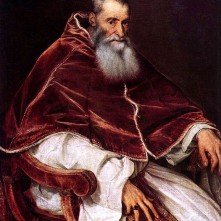
Pope Paul III
1550 – Birth of Henry Cavendish, soldier, traveller and son of Bess of Hardwick and Sir William Cavendish. He was married to Grace Talbot, daughter of George Talbot, 6th Earl of Shrewsbury. This match was arranged by his mother who had married the Earl of Shrewsbury.
1559 – Matthew Parker was consecrated as Elizabeth I's Archbishop of Canterbury. According to “The Correspondence of Matthew Parker”, Anne Boleyn charged him with the care of Elizabeth when she saw him in April 1536, "not six days before her apprehension". Historian Eric Ives writes that this was a request that Parker never forgot, and something which stayed with him for ever. Parker obviously came to be important to Elizabeth, because she made him her Archbishop of Canterbury in 1559. It was a post which Parker admitted to Lord Burghley, he would not have accepted if he “had not been so much bound to the mother”. Parker was Archbishop until his death in 1575.
18 December
1555 – Burning of John Philpott, former Archdeacon of Winchester and Protestant martyr, at Smithfield. He had been imprisoned in London's coalhouse prison after writing letters to fellow Protestants to encourage them to stay strong in their faith. He was moved to the tower of St Paul's Cathedral, where he was put into solitary confinement before being condemned for heresy by Bishop Bonner.
1575 - Nicholas Harpsfield, historian, Catholic apologist, priest and former Archdeacon of Canterbury, died in London. He had been released from Fleet prison four months earlier due to ill health.
19 December
1562 – The Battle of Dreux between Catholics, led by Anne de Montmorency, and Huguenots, led by Louis I, Prince of Condé, during the first war of the French Wars of Religion. The Catholics were victorious, but both commanders were taken prisoner.
1576 - Katherine Palmer, Abbess of Syon, died in Mechelen during exile in Elizabeth I's reign. Just over a month earlier, on 8th November, her convent had been broken into by a mob of Calvinists, and it is thought that confronting the mob had been too traumatic for her. She was laid to rest at Mechelen in the Church of the Augustinians.
1578 (19th or 26th December) – Executions of Egremont Radcliffe and a man called Gray at Namur in Belgium. They were beheaded in the marketplace after being suspected of poisoning Don John of Austria.
1583 – John Somerville, convicted conspirator, was found dead in his cell at Newgate Prison. Death was by strangulation, and it was said that his death was suicide. His body was buried in Moorfields, and his head was put on display on London Bridge. Somerville had been convicted of high treason for intending to shoot and kill Elizabeth I.
1587 – Death of Thomas Seckford, lawyer and administrator, at Clerkenwell in Middlesex. He was buried at Clerkenwell, but then moved to the family vault at Woodbridge in Suffolk. Seckford served Mary I as Deputy Chief Steward of the Duchy of Lancaster and Elizabeth I as Master of Requests and Steward of the Marshalsea court.
20 December
1541 – A “very sickly” Agnes Tilney, Dowager Duchess of Norfolk, who was imprisoned in the Tower of London after the fall of her granddaughter, Catherine Howard, begged Henry VIII for forgiveness. She also confessed to having another £800 hidden at Norfolk House.
1558 – Death of John Holyman, Bishop of Bristol and Rector of Hanborough in Oxfordshire. He was buried at Hanborough Church, in the chancel.
1559 – Burial of John Bekinsau (Beckinsau), scholar and theologian, at Sherborne St John in Hampshire. Bekinsau was the author of the 1546 tract De supremo et absoluto regis imperio in support of Henry VIII's supremacy.
1562 – Death of Margaret Kitson (other married name Bourchier and née Donnington), Countess of Bath. She was buried at the church in Hengrave, near Bury St Edmunds in Suffolk, which was near Hengrave Hall, the Kitson family seat. Margaret was the second wife of merchant adventurer Sir Thomas Kitson.
1571 – Death of Richard Butler, 1st Viscount Mountgarret and son of Piers Butler, 1st Earl of Ossory and 8th Earl of Ormond. He was buried in St Canice's Cathedral, Kilkenny city.
1583 – Execution of Edward Arden, conspirator, at Smithfield. He was hanged, drawn and quartered after being convicted of high treason for plotting with John Somerville to kill Elizabeth I. Like Somerville, his body was buried at Moorfields and his head displayed on London Bridge.
1606 – Death of Richard Reynolds (Rainolde), clergyman and author, in Essex. His work included the 1563 “ A booke called the foundacion of rhetorike, because all other partes of rhetorike are grounded thereupon” and “ A chronicle of all the noble emperours of the Romaines … setting forth the great power, and devine providence of almighty God, in preserving the godly princes and common wealthes” (1571).

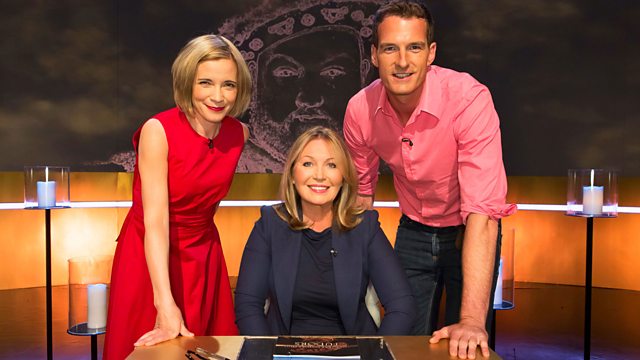
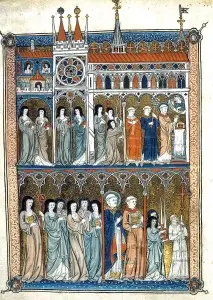
Leave a Reply